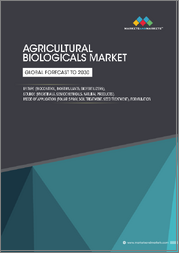
|
시장보고서
상품코드
1576676
미생물 제어 화학제품 시장 규모, 점유율, 예측, 동향 분석 : 방법별(살균, 소독, 방부), 유형별(페놀, 할로겐, 알데히드, 알코올), 최종 이용 산업별(수처리, 의료) - 세계 예측(-2031년)Microbial Control Chemical Market Size, Share, Forecast, & Trends Analysis by Method (Sterilization, Disinfection, Antisepsis), Type (Phenolics, Halogens, Aldehyde, Alcohol), End-use Industry (Water Treatment, Healthcare) - Global Forecast to 2031 |
||||||
미생물 제어 화학제품 시장은 2031년까지 83억 4,000만 달러에 달할 것으로 예상되며, 2024년부터 2031년까지 6.1%의 연평균 복합 성장률(CAGR)을 나타낼 전망입니다. 이 보고서는 5개 주요 지역의 미생물 방제용 화학물질 시장에 대한 상세한 분석, 현재 시장 동향, 규모, 최근 동향, 2031년 예측 등을 담고 있습니다.
광범위한 2차 조사와 1차 조사, 시장 시나리오에 대한 심층 분석을 통해 주요 산업의 촉진요인, 억제요인, 기회, 과제 및 동향에 대한 영향 분석을 수행합니다.
미생물 제어 화학물질 시장의 성장은 주로 식품 가공 산업의 성장과 식품 안전에 대한 관심 증가, 수처리에 대한 수요 증가, 다양한 산업 분야의 위생 및 제품 안전에 대한 엄격한 규제에 의해 주도되고 있습니다. 그러나 다양한 산업에서 위생 및 제품 안전에 대한 엄격한 규제와 이러한 화학 물질에 대한 미생물 내성의 출현은 이 시장의 성장을 억제할 수 있습니다.
또한, 위생과 청결의 중요성에 대한 인식이 높아지고 미생물 제어 화학제품의 기술 발전은 이 시장의 이해관계자들에게 큰 성장 기회를 제공할 것으로 예상됩니다. 반면, 이러한 화학물질의 사용에 따른 환경적 우려는 미생물 제어 화학물질 시장의 성장에 영향을 미치는 주요 과제로 작용하고 있습니다.
목차
제1장 서론
제2장 조사 방법
제3장 주요 요약
- 개요
- 부문 분석
- 미생물 제어용 화학제품 시장 : 방법별
- 미생물 제어용 화학제품 시장 : 유형별
- 미생물 제어용 화학제품 시장 : 최종 이용 산업별
- 미생물 제어용 화학제품 시장 : 지역별 분석
- 경쟁 구도와 시장 경쟁
제4장 시장 인사이트
- 시장 개요
- 시장 성장에 영향을 미치는 요인
- 성장 촉진요인
- 성장 억제요인
- 기회
- 과제
- 동향
- Porter의 Five Forces 분석
제5장 미생물 제어용 화학제품 시장 평가 : 방법별
- 개요
- 살균
- 소독
- 방부
제6장 미생물 제어용 화학제품 시장 평가 : 유형별
- 개요
- 페놀
- 할로겐
- 산화제
- 알데히드
- 알코올
- 중금속
- 기타 미생물 제어용 화학제품
제7장 미생물 제어용 화학제품 시장 평가 : 최종 이용 산업별
- 개요
- 수처리
- 의료
- 퍼스널케어
- 식품 및 음료
- 목재 보존
- 석유 및 가스
- 기타 최종 이용 산업(농업, 가정용/상업용 클리닝, 섬유, 페인트 및 코팅제)
제8장 미생물 제어용 화학제품 시장 평가 : 지역별
- 개요
- 북미
- 미국
- 캐나다
- 유럽
- 독일
- 스페인
- 프랑스
- 영국
- 이탈리아
- 기타 유럽(RoE)
- 아시아태평양
- 중국
- 인도
- 일본
- 호주
- 기타 아시아태평양(RoAPAC)
- 라틴아메리카
- 브라질
- 멕시코
- 아르헨티나
- 기타 라틴아메리카
- 중동 및 아프리카
제9장 경쟁 분석
- 개요
- 주요 성장 전략
- 경쟁 벤치마킹
- 경쟁 대시보드
- 업계 리더
- 시장 차별화 요인
- 선구 기업
- 신규 기업
- 주요 기업별 시장 점유율 분석(2023년)
제10장 기업 개요(기업 개요, 재무 개요, 제품 포트폴리오, 전략 전개 상황)
- Lonza Group Ltd.
- Solvay S.A.
- LANXESS AG
- Clariant AG
- The Dow Chemical Company
- Ecolab Inc.
- Thor GmbH
- BASF SE
- Stepan Company
- Albemarle Corporation
(주 : 주요 5개사의 SWOT 분석을 게재 예정)
제11장 부록
LSH 24.11.12Microbial Control Chemicals Market Size, Share, Forecast, & Trends Analysis by Method (Sterilization, Disinfection, Antisepsis), Type (Phenolics, Halogens, Aldehyde, Alcohol), End-use Industry (Water Treatment, Healthcare)-Global Forecast to 2031
According to a new market research report titled, Microbial Control Chemicals Market Size, Share, Forecast, & Trends Analysis by Method (Sterilization, Disinfection, Antisepsis), Type (Phenolics, Halogens, Aldehyde, Alcohol), End-use Industry (Water Treatment, Healthcare)-Global Forecast to 2031,' published by Meticulous Research(R), the microbial control chemicals market is projected to reach $8.34 billion by 2031, at a CAGR of 6.1% from 2024 to 2031. The report provides an in-depth analysis of the microbial control chemicals market across five major geographies, current market trends, size, and recent developments, and the forecast for 2031.
Succeeding extensive secondary and primary research and an in-depth analysis of the market scenario, the report conducts the impact analysis of the key industry drivers, restraints, opportunities, challenges, and trends.
The growth of the microbial control chemicals market is primarily driven by the growth in the food processing industry and rising concerns regarding food safety, the growing need for water treatment, and the stringent regulations regarding hygiene and product safety in various industries. However, stringent regulations regarding hygiene & product safety in various industries and the emergence of microbial resistance to these chemicals may restrain the growth of this market.
Furthermore, the growing awareness about the importance of hygiene and cleanliness and technological advancements in microbial control chemicals are expected to create significant growth opportunities for the stakeholders in this market. On the other hand, the environmental concerns associated with the use of these chemicals pose a major challenge impacting the growth of the microbial control chemicals market.
Key Players
The key players operating in the microbial control chemicals market are Lonza Group Ltd. (Switzerland), Solvay S.A. (Belgium), LANXESS AG (Germany), Clariant AG (Switzerland), The Dow Chemical Company (U.S.), Ecolab Inc. (U.S.), Thor GmbH (Germany), BASF SE (Germany), Stepan Company (U.S.), and Albemarle Corporation (U.S.).
Based on method, the microbial control chemicals market is segmented into sterilization, disinfection, and antisepsis. In 2024, the sterilization segment is expected to account for the largest share of the microbial control chemicals market. This segment's large market share is driven by increasing demand for sterilization in pharmaceutical, healthcare, and food processing facilities and advancements in sterilization chemicals.
However, the disinfection segment is projected to record the highest CAGR during the forecast period. This segment's rapid growth is primarily driven by rising awareness about hygiene, advancements in disinfection technologies, the introduction of eco-friendly disinfection solutions, and expanding applications of various microbial control chemicals, such as aldehydes, oxidizing agents, halogens, alcohols, and phenolics.
Based on Type, the microbial control chemicals market is segmented into phenolics, halogens, oxidizing agents, aldehyde, alcohol, heavy metals, and other microbial control chemicals. In 2024, the phenolics segment is expected to account for the largest share of 36.0% of the microbial control chemicals market. This segment's large market share is due to increasing demand for effective disinfection solutions, concerns over microbial contamination, and increasing utilization of phenolics in healthcare and food processing.
Based on End-use Industry, the microbial control chemicals market is segmented into water treatment, healthcare, personal care, food & beverage, wood preservation, oil & gas, and other end-use industries. In 2024, the water treatment segment is expected to account for the largest share of the microbial control chemicals market. This segment's large market share is attributed to declining freshwater resources, rising incidence of waterborne diseases, rapid population growth & urbanization, stringent water treatment & environmental regulations.
Based on geography, the microbial control chemicals market is majorly segmented into five regions: North America, Europe, Asia-Pacific, Latin America, and the Middle East & Africa. In 2024, North America is expected to account for the largest share of the microbial control chemicals market, followed by Asia-Pacific, Europe, Latin America, and Middle East & Africa. The large share of this regional market is attributed to the presence of major market players, well-established food processing and pharmaceutical industries, and strict regulations regarding food safety & hygiene in the region, and advanced healthcare infrastructure.
Key Questions Answered in the Report:
- What is the value of revenue generated by the sale of microbial control chemicals?
- At what rate is the demand for microbial control chemicals market projected to grow for the next 5-7 years?
- What is the historical market size and growth rate for the microbial control chemicals market?
- What are the major factors impacting the growth of this market at global and regional levels?
- What are the major opportunities for existing players and new entrants in the market?
- Which method, type, and end-use industry segments create major traction for the manufacturers in this market?
- What are the key geographical trends in this market? Which regions/countries are expected to offer significant growth opportunities for the manufacturers operating in the microbial control chemicals market?
- Who are the major players in the microbial control chemicals market? What are their specific product offerings in this market?
- What recent developments have taken place in the microbial control chemicals market? What impact have these strategic developments created on the market?
Scope of the Report:
Microbial Control Chemicals Market Assessment-by Method
- Sterilization
- Disinfection
- Antisepsis
Microbial Control Chemicals Market Assessment-by Type
- Phenolics
- Halogens
- Oxidizing Agents
- Aldehyde
- Alcohol
- Heavy Metal
- Other Microbial Control Chemicals
Microbial Control Chemicals Market Assessment-by End-use Industry
- Water Treatment
- Healthcare
- Personal Care
- Food & Beverages
- Wood Preservation
- Oil & Gas
- Other End-use Industries
Microbial Control Chemicals Market Assessment-by Geography
- North America
- U.S.
- Canada
- Europe
- Germany
- Spain
- France
- U.K.
- Italy
- Rest of Europe (RoE)
- Asia-Pacific
- China
- India
- Japan
- Australia
- Rest of Asia-Pacific (RoAPAC)
- Latin America
- Brazil
- Mexico
- Argentina
- Rest of Latin America (RoLATAM)
- Middle East & Africa
TABLE OF CONTENTS
1. Introduction
- 1.1. Market Definition & Scope
- 1.2. Market Ecosystem
- 1.3. Currency
- 1.4. Key Stakeholders
2. Research Methodology
- 2.1. Research Approach
- 2.2. Process of Data Collection and Validation
- 2.2.1. Secondary Research
- 2.2.2. Primary Research/Interviews with Key Opinion Leaders of the Industry
- 2.3. Market Sizing and Forecast
- 2.3.1. Market Size Estimation Approach
- 2.3.2. Growth Forecast Approach
- 2.4. Assumptions for the Study
3. Executive Summary
- 3.1. Overview
- 3.2. Segment Analysis
- 3.2.1. Microbial Control Chemical Market, by Method
- 3.2.2. Microbial Control Chemical Market, by Type
- 3.2.3. Microbial Control Chemical Market, by End-use Industry
- 3.3. Microbial Control Chemical Market: Regional Analysis
- 3.4. Competitive Landscape & Market Competitors
4. Market Insights
- 4.1. Overview
- 4.2. Factors Affecting Market Growth
- 4.2.1. Drivers
- 4.2.1.1. Growth in the Food Processing Industry and Rising Concerns Regarding Food Safety
- 4.2.1.2. Growing Need for Water Treatment
- 4.2.1.3. Stringent Regulations Regarding Hygiene and Product Safety in Various Industries
- 4.2.2. Restraints
- 4.2.2.1. Regulatory Complexities Regarding the Use of Microbial Control Chemical
- 4.2.2.2. Emergence of Microbial Resistance to These Chemicals
- 4.2.3. Opportunities
- 4.2.3.1. Growing Awareness about the Importance of Hygiene and Cleanliness
- 4.2.3.2. Technological Advancements in Microbial Control Chemicals
- 4.2.4. Challenges
- 4.2.4.1. Environmental Concerns Associated With the Use of These Chemicals
- 4.2.1. Drivers
- 4.3. Trend
- 4.4. Porter's Five Forces Analysis
- 4.4.1. Bargaining Power of Suppliers
- 4.4.2. Bargaining Power of Buyers
- 4.4.3. Threat of Substitutes
- 4.4.4. Threat of New Entrants
- 4.4.5. Degree of Competition
5. Microbial Control Chemical Market Assessment-by Method
- 5.1. Overview
- 5.2. Sterilization
- 5.3. Disinfection
- 5.4. Antisepsis
6. Microbial Control Chemical Market Assessment-by Type
- 6.1. Overview
- 6.2. Phenolics
- 6.3. Halogens
- 6.4. Oxidizing Agents
- 6.5. Aldehyde
- 6.6. Alcohol
- 6.7. Heavy Metal
- 6.8. Other Microbial Control Chemicals
7. Microbial Control Chemical Market Assessment-by End-use Industry
- 7.1. Overview
- 7.2. Water Treatment
- 7.3. Healthcare
- 7.4. Personal Care
- 7.5. Food & Beverages
- 7.6. Wood Preservation
- 7.7. Oil & Gas
- 7.8. Other End-use Industries (Agriculture, Household & Commercial Cleaning, Textile, Paints & Coatings)
8. Microbial Control Chemical Market Assessment-by Geography
- 8.1. Overview
- 8.2. North America
- 8.2.1. U.S.
- 8.2.2. Canada
- 8.3. Europe
- 8.3.1. Germany
- 8.3.2. Spain
- 8.3.3. France
- 8.3.4. U.K.
- 8.3.5. Italy
- 8.3.6. Rest of Europe (RoE)
- 8.4. Asia-Pacific
- 8.4.1. China
- 8.4.2. India
- 8.4.3. Japan
- 8.4.4. Australia
- 8.4.5. Rest of Asia-Pacific (RoAPAC)
- 8.5. Latin America
- 8.5.1. Brazil
- 8.5.2. Mexico
- 8.5.3. Argentina
- 8.5.4. Rest of Latin America
- 8.6. Middle East & Africa
9. Competition Analysis
- 9.1. Overview
- 9.2. Key Growth Strategies
- 9.3. Competitive Benchmarking
- 9.4. Competitive Dashboard
- 9.4.1. Industry Leaders
- 9.4.2. Market Differentiators
- 9.4.3. Vanguards
- 9.4.4. Emerging Companies
- 9.5. Market Share Analysis, by Key Players (2023)
10. Company Profile (Company Overview, Financial Overview, Product Portfolio, and Strategic Developments)
- 10.1. Lonza Group Ltd.
- 10.2. Solvay S.A.
- 10.3. LANXESS AG
- 10.4. Clariant AG
- 10.5. The Dow Chemical Company
- 10.6. Ecolab Inc.
- 10.7. Thor GmbH
- 10.8. BASF SE
- 10.9. Stepan Company
- 10.10. Albemarle Corporation
(Note: SWOT Analysis of the Top 5 Companies Will Be Provided.)
11. Appendix
- 11.1. Available Customization
- 11.2. Related Reports



















